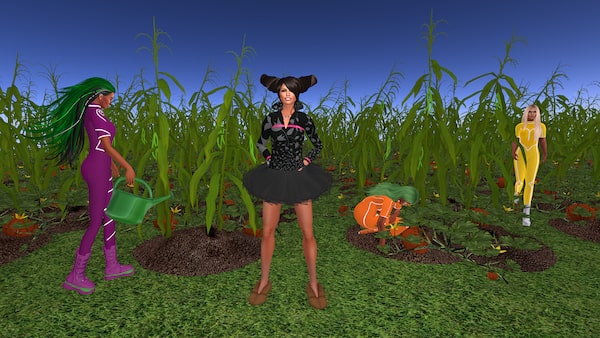
Vickie Vainionpää’s Gaze Paintings on display at Olga Korper Gallery. The artists used eye-movement tracking software to inspire the series.Courtesy Olga Korper Gallery
You can’t help but be caught up in the swirling tubular lines that tumble through Vickie Vainionpää's paintings. Twisting forcefully yet gracefully, her gestures, often rendered in florid neon hues, feel at once fluidly organic and yet purpose driven. On closer inspection of the Montreal-based artist’s more recent oil on canvas works, the images of faces and bodies materialize from within the corkscrew-silhouetted translucent forms she masterfully articulates.
These glimpses of human presence reflect the painter’s source material for the pieces in her show Gaze Paintings, on until April 27 at Toronto’s Olga Korper Gallery. Here, Vainionpää reinterprets in a beguiling and modern way the male gaze cultivated by female nude-centric works by the likes of Peter Paul Rubens and Jacopo Tintoretto. The shapes she has painted have been informed by intel gathered through the use of eye movement-tracking hardware and generative 3D software, plus a plugin she wrote in collaboration with her partner, data scientist Harry Vallianos.
“I’ve always been a painter first, and I’ve always been interested in how to make a painting,” Vainionpää says about her practice. “We also live in a digitally saturated world, and I feel like it’s my duty to reflect the time that I’m living in and to use these tools in my process.”
Many creatives echo this idea, using digital tools to inform their art. Computer-crafted works are appearing in an increasing number of venues, from galleries to art fairs. Augmented reality experiences and virtual reality headsets have also become more common in art-centric spaces, such as at Shezad Dawood’s multidisciplinary exhibition on until May 5 at Toronto’s Aga Khan Museum. The show boasts an immersive virtual reality (VR) component that more than one visitor can interact with at a time, making art something viewers can actively participate in as well as engage with as a viewer.
Gaze Paintings poses the question: “What does it mean to look at a painting?” Most of the pieces represent Vainionpää's own visual journey as she viewed some of history’s most vaunted works, with her eye movements being tracked and captured by hardware made by Pupil Labs. The company’s glasses, which Vainionpää added to her artistic toolkit in 2022, have forward-facing cameras that record different data points such as cicada amplitude (how much the eye moves back and forth), fixation points and fixation duration.

We Call Them The Sustainers, by multimedia artist Skawennati. She created animated videos on the interactive platform Second Life.Courtesy Ellephant
The data are then imported to a computer to create a variety of different visual forms that Vainionpää uses as inspiration to create the final work she crafts with oil paints. Vainionpää also used the optical actions of over 100 volunteers who answered her call out on Instagram for works The Painter’s Studio and The Dream; their data points were collected using a webcam eye-tracking platform.
“Taking that data as a starting point is like reflecting the painting back on itself and asking questions of it,” she says, adding that she discovered consistent areas of lingering across her subjects’ gaze so far. “There’s an effort to reveal some sort of hidden logic behind every painting, which I find fascinating.”
Two new additions to Vainionpää's series, The Judgment of Paris (Excerpt I) and (Excerpt 2), were on view at the Patrick Mikhail Gallery booth during the recent Plural art fair in Montreal. Referencing Ruben’s work, these canvases are even more colourful and hypnotic in nature.
“Technology is something that supports her talent,” says Plural’s new general director, Anie Deslauriers, when asked about Vainionpää's oeuvre in the context of digital art. “Artists will go from integrating parts of these technologies to support what they’re trying to say through to the other end of the spectrum where artists can create an entire world.”
At the fair, the gallery Ellephant’s booth, for example, showcased multimedia artist Skawennati’s Indigenous Futurism-focused work. She’s perhaps best known for her animated videos crafted on the interactive platform Second Life.
Deslauriers notes that integrating digitally presented art into personal, corporate and institutional collections has introduced new considerations in terms of archiving. “We have to keep researching and developing different methods of preserving these works,” she says. After all, as time wears on, a new media work will be considered just as vital to the canon as one of the pieces fixated on in a painting by Vainionpää.
“I think that as a painter, you assume that people are going to look back on your work and reference it,” she says, noting that one day she hopes to capture the experience of someone looking at a piece of art in a gallery or museum setting instead of through a webcam. “You hope that it means something to people in the future.”